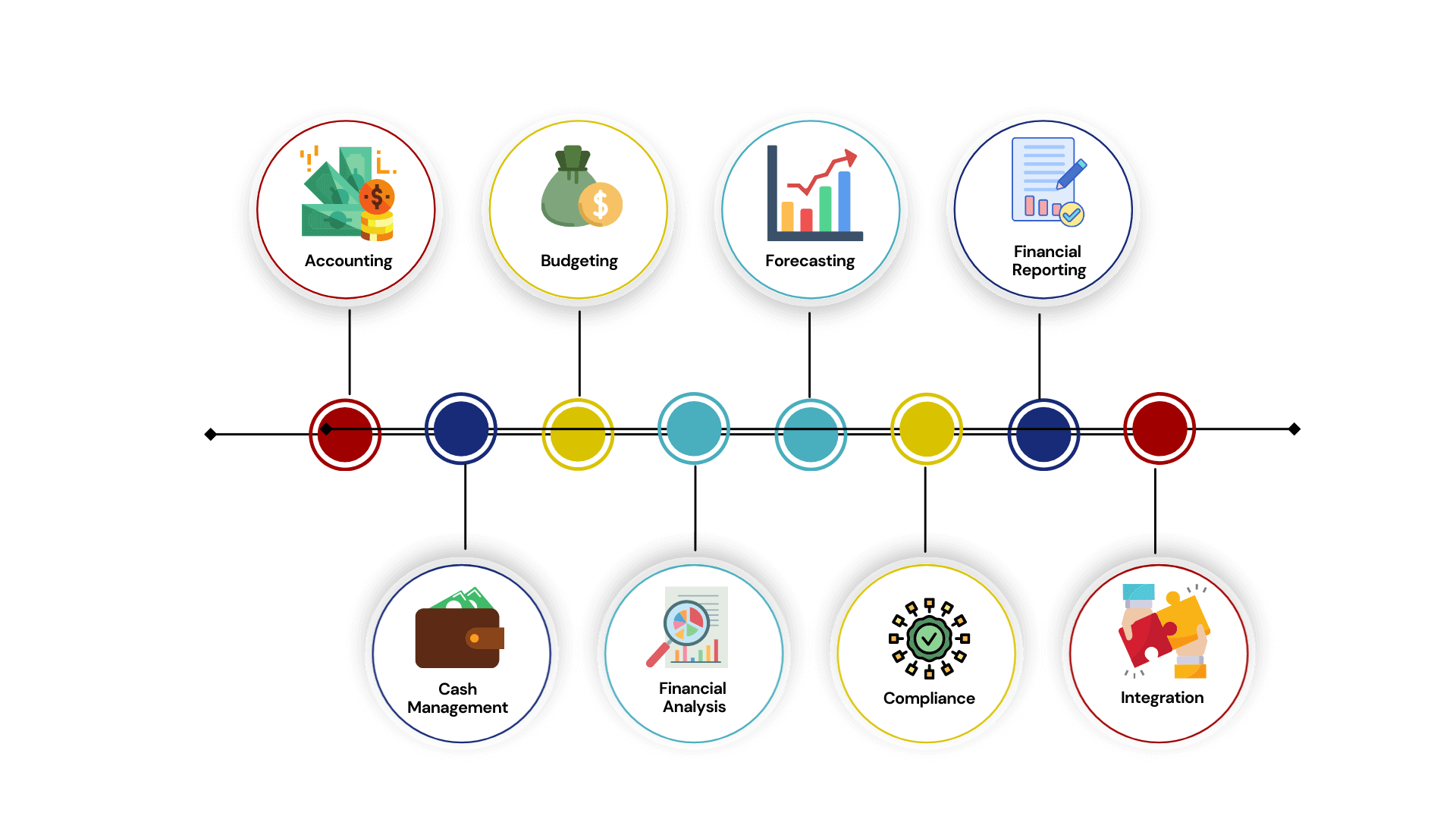
Home »
How KEBS Streamlines Financial Management for Businesses
Explore how businesses achieve efficiency and growth through streamlined financial processes.
Overview of financial management?
It is the process of planning, organizing, directing, and controlling financial activities within an organization. It involves the effective utilization of financial resources to achieve organizational goals and objectives. Financial management is important for all types of organizations to allocate resources effectively and maintain financial stability.
The primary goal of financial management is to maximize shareholder wealth. It involves identifying and managing financial risks, ensuring sufficient cash flow, maintaining financial records, and ensuring compliance with financial regulations.There are various components of financial management, including financial planning and analysis, financial reporting, accounting, budgeting, and forecasting.
What is financial management software?
It is a tool or system that automates financial management processes and provides businesses with real-time visibility into their financial performance. It is a comprehensive software system that integrates all aspects of financial management, including accounting, budgeting, forecasting, and reporting.
Financial management software can help businesses to streamline their financial management processes, reduce errors and fraud, and make better-informed financial decisions. The software provides businesses with a complete view of their financial performance, enabling them to track expenses, manage budgets, forecast revenue and cash flow, generate financial reports, and monitor financial performance.

Financial management software is designed to simplify financial management tasks and save time for businesses. It eliminates the need for manual processes and reduces the risk of errors. It can also improve financial reporting and compliance by automating financial reporting processes and ensuring compliance with financial regulations.
Financial management software is typically cloud-based, meaning that it is accessible from anywhere with an internet connection. This makes it easy for businesses to manage their finances on the go and collaborate with others in real-time. Additionally, financial management software can integrate with other business systems, such as payroll and inventory management, to provide a complete view of the business’s financial performance.
Essential components of a financial management system
A financial management system is a comprehensive software system that automates financial management processes and provides businesses with real-time visibility into their financial performance. The essential components of a financial management system include:
- Accounting: The accounting component of a financial management system is used to record financial transactions, create invoices, manage accounts receivable and payable, and generate financial statements. It helps businesses to maintain accurate financial records and ensure compliance with financial regulations.
Budgeting: The budgeting component of a financial management system is used to create budgets and track expenses against the budget. It allows businesses to monitor spending and ensure that they stay within their budget.

- Forecasting: The forecasting component of a financial management system is used to predict future financial performance based on historical data and other relevant factors. It helps businesses to make informed financial decisions and plan for the future.
Financial Reporting: The financial reporting component of a financial management system is used to create financial reports, including income statements, balance sheets, and cash flow statements. These reports provide an overview of the organization’s financial performance.
Cash Management: The cash management component of a financial management system is used to manage cash flow and ensure that businesses have sufficient cash to meet their financial obligations. It can also help businesses to optimize their cash flow by managing collections and payments.
Financial Analysis: The financial analysis component of a financial management system is used to analyze financial data to identify trends and patterns, and make informed financial decisions. It helps businesses to understand their financial performance and identify areas for improvement.
Compliance: The compliance component of a financial management system is used to ensure compliance with financial regulations and standards. It helps businesses to maintain accurate financial records and ensure that they are following all financial regulations.
Integration: The integration component of a financial management system is used to integrate with other business systems, such as payroll and inventory management, to provide a complete view of the business’s financial performance.
Roles and responsibilities of a financial managers
Financial managers play a crucial role in an organization’s financial success. Their roles and responsibilities typically include:
- Financial managers are involved in creating and managing budgets. They collaborate with department heads to develop budget plans, monitor spending, and provide guidance on financial targets. They also forecast future financial performance based on historical data and market trends.
- Financial managers oversee the preparation of financial reports, including income statements, balance sheets, and cash flow statements. They ensure accurate and timely reporting in compliance with accounting standards and regulatory requirements.
- Financial managers monitor and manage cash flow to ensure sufficient funds are available for daily operations, payments, and investments. They optimize cash flow by analyzing receivables, payables, and working capital needs.
- Financial managers assess and mitigate financial risks that could impact the organization’s stability and profitability. They develop risk management strategies, such as hedging against currency fluctuations or interest rate changes, to protect the organization’s financial assets.
- Financial managers ensure compliance with financial regulations and laws. They stay updated on changes in financial regulations and implement necessary controls and procedures to meet compliance requirements.
- Financial managers are involved in evaluating investment opportunities and making informed decisions regarding capital allocation. They analyze investment options, assess their potential returns and risks, and make recommendations on investments or financing strategies.
- Financial managers provide strategic financial guidance to senior management and contribute to overall business strategy. They analyze financial data, conduct feasibility studies, and make recommendations on major financial decisions, such as mergers and acquisitions or capital structure changes.
- Financial managers interact with external stakeholders, such as banks, investors, auditors, and regulatory bodies. They manage relationships with financial institutions, negotiate financing terms, and provide financial information for audits and compliance purposes.
| Roles and Responsibilities of Financial Managers | Specific Responsibilities |
|---|---|
| Budget Creation and Management | Collaborating with department heads to create budgets, monitoring spending, and forecasting financial performance. |
| Financial Reporting | Overseeing preparation of accurate financial reports, including income statements, balance sheets, and cash flow statements, ensuring compliance. |
| Cash Flow Management | Monitoring and managing cash flow, analyzing receivables, payables, and working capital to ensure sufficient funds. |
| Risk Assessment and Mitigation | Assessing and managing financial risks, developing risk management strategies to safeguard financial assets. |
| Compliance and Regulation | Ensuring compliance with financial regulations, implementing controls, and staying updated on regulatory changes. |
| Investment Evaluation | Evaluating investment opportunities, analyzing returns and risks, and recommending investments or financing strategies. |
| Strategic Financial Guidance | Providing strategic financial insights, analyzing data, contributing to major decisions such as mergers, acquisitions, or capital changes. |
Importance of streamlining financial management processes
Streamlining financial management processes is critical for organizations to improve their financial performance, reduce costs, and ensure compliance with financial regulations. Some of the key reasons why streamlining financial management processes is important are:
- Increased Efficiency: By streamlining financial management processes, organizations can eliminate redundant and manual processes, automate tasks, and improve workflow efficiency.
- Improved Financial Reporting: Streamlining financial management processes can improve the accuracy and timeliness of financial reporting.
- Better Control and Governance: Streamlining financial management processes can help organizations establish better control and governance over their financial operations. By implementing standardized processes and controls, organizations can reduce the risk of fraud, errors, and non-compliance.
- Improved Cash Flow Management: Streamlining financial management processes can help organizations manage their cash flow more effectively.
- Enhanced Financial Analysis: By automating financial data collection and analysis, organizations can identify trends, patterns, and opportunities for improvement.
- Improved Customer Service: By automating billing and payment processes, organizations can provide customers with more accurate and timely billing information and improve payment processing times.
- Cost Savings: Streamlining financial management processes can help organizations reduce costs by eliminating redundant processes, reducing errors, and optimizing resources.
Benefits of financial Management Software
- Automation: Financial management software automates manual processes such as data entry, invoicing, payment processing, and financial reporting. This reduces the time and effort required to manage financial tasks and ensures accuracy and consistency.
Centralization: Financial management software centralizes financial data, making it easier to access and analyze financial information. This eliminates the need to use multiple systems or spreadsheets, which can cause errors and inconsistencies.
Real-time data: Financial management software provides real-time access to financial data, enabling organizations to make informed decisions based on up-to-date information.
Improved accuracy: Financial management software reduces the risk of errors and mistakes by automating processes and ensuring consistent data entry. This improves the accuracy of financial information and reduces the risk of financial losses.
Scalability: Financial management software can be scaled to meet the needs of growing organizations. It provides the flexibility to add new users, features, or modules as required.

Factors to consider when choosing a financial management software solution
Some of the key factors to consider when choosing a financial management software solution include:
- Business requirements: The first step in choosing a financial management software solution is to identify your organization’s specific business requirements. This will help you determine which features and capabilities are necessary to meet your needs.
Integration with other systems: Financial management software should be able to integrate with other systems your organization uses, such as ERP, CRM, and payroll systems. Integration with other systems ensures that data is consistent across all systems and eliminates the need for manual data entry.
User interface and ease of use: A financial management software solution should be easy to use and have an intuitive user interface. This ensures that users can easily navigate the system and perform the tasks they need to do without extensive training.

- Scalability: A financial management software solution should be scalable to meet the needs of growing organizations. The solution should be able to accommodate additional users, modules, or features as the organization grows.
- Security: Financial management software should have robust security features to protect financial data. The solution should include features such as access controls, user authentication, and data encryption.
- Cost: The cost of a financial management software solution is an important factor to consider. Organizations should consider the total cost of ownership, including licensing fees, implementation costs, training costs, and ongoing maintenance and support costs.
- Vendor reputation: The reputation of the vendor providing the financial management software solution is an important consideration. Organizations should research the vendor’s track record, customer reviews, and customer support capabilities.
- Support and training: A financial management software solution should include support and training options to ensure that users can get the help they need if they encounter issues or have questions about the system.
Best practices for using financial management software effectively
| Financial Management Best Practices | Key Considerations |
|---|---|
| Standardize Processes | Ensuring consistency and accuracy by standardizing financial processes and workflows across the organization. |
| Regular Data Review and Reconciliation | Maintaining accuracy and detecting discrepancies by regularly reviewing and reconciling financial data. |
| Utilize Reporting and Analytics | Making informed decisions by leveraging powerful reporting and analytics features in financial management software. |
| Prioritize Training and Support | Ensuring effective software utilization through investments in user training and dedicated support. |
| Regular Software Updates and Maintenance | Maintaining security and functionality by routinely updating and maintaining financial management software. |
- Standardize processes: Standardizing financial processes and workflows across the organization helps to ensure consistency and accuracy.
- Regularly review and reconcile financial data: Regularly reviewing and reconciling financial data is critical to ensure accuracy and identify discrepancies.
- Leverage reporting and analytics: Financial management software provides powerful reporting and analytics capabilities that can help organizations make data-driven decisions.
- Invest in training and support: Training and support are critical to ensuring that users can effectively use financial management software.
- Regularly update and maintain the software: Regularly updating and maintaining financial management software is critical to ensure that the system remains secure and up-to-date.
Discussion of common challenges faced by financial managers
Some of the common challenges faced by financial managers include:
Staying up-to-date with changing regulations and standards: Financial regulations and standards are constantly changing, and financial managers must stay up-to-date with these changes to ensure compliance. Failure to comply with regulations can result in penalties, fines, or legal action.
- Managing cash flow: Managing cash flow is a key responsibility of financial managers. This involves ensuring that there is enough cash on hand to meet the organization’s financial obligations, while also investing excess cash in a way that maximizes returns.
- Balancing short-term and long-term financial goals: Financial managers must balance the organization’s short-term financial goals, such as meeting payroll and paying bills, with its long-term financial goals, such as investing in research and development or expanding into new markets.
- Managing risk: Financial managers must manage financial risk, such as credit risk, market risk, and operational risk. This involves identifying potential risks, developing strategies to mitigate them, and monitoring risk exposure.

- Managing financial data: Financial managers are responsible for managing vast amounts of financial data, including budgets, financial statements, and financial forecasts.
- Communicating financial information: Effective communication is critical to ensuring that stakeholders understand the organization’s financial performance and can make informed decisions.
- Managing internal controls: Financial managers must develop and implement internal controls to prevent fraud, ensure accuracy, and protect financial data
This requires ongoing monitoring and auditing to ensure that internal controls are effective and being followed.
How KEBS financial management helps to address the challenges?
KEBS finance management offers a comprehensive solution to help finance managers address the challenges they face. Here are some examples:
- MIS: KEBS finance offers a visual way of tracking the progress of your projects, enabling you to have real-time visibility into the financial health of your organization.
- Accounts Payable and Receivable: KEBS finance helps to automate manual tasks and set individual and team project milestones to ensure timely completion of projects, which helps in preventing revenue leakage.
- Cash Flow: KEBS finance enables you to make every second count with accurate time tracking and cash flow management.
Profitability Analysis: KEBS finance helps to record issues and their solutions to create a comprehensive database for future projects, which helps to improve profitability and avoid repeated mistakes.- Consolidation: KEBS finance helps in planning and executing multiple projects with precision by making data-driven decisions, which helps in optimizing resources and minimizing risks.
- Procurement: KEBS finance enables you to ensure timely completion of milestones with project-based timesheets, which helps in managing expenses and optimizing resources.
- Invoicing and Revenue Recognition: KEBS finance provides ready-made project templates for swift completion of projects and accurate revenue recognition, which helps in improving efficiency and financial reporting.
- Collector – The Collection Management: KEBS finance ensures timely completion of milestones with project-based timesheets and provides an efficient system to manage collections, which helps in improving cash flow and reducing bad debts.
- General Ledger and Cost Accounting: KEBS finance enables you to brainstorm with your team even while working remotely to deliver projects with perfection, which helps in improving accuracy and minimizing errors.
Benefits of using KEBS for financial management
Using KEBS for financial management can bring several benefits, including:
- Enhanced efficiency: KEBS offers features like automated manual tasks, project-based timesheets, and visual tracking of progress that can save time and increase efficiency.
- Timely completion of projects: The ability to set individual and team project milestones and ensure timely completion of projects can be a significant advantage in meeting project deadlines.
- Better decision-making: KEBS’ data-driven decision-making capabilities and profitability analysis can provide insights into project performance and help identify areas for improvement.
- Improved communication and collaboration: Features like brainstorming with teams even while working remotely and ready-made project templates can facilitate communication and collaboration among team members.
- Accurate financial tracking: KEBS’ cash flow and revenue recognition features can help in accurate financial tracking and forecasting.
- Comprehensive database: Recording issues and their solutions can create a comprehensive database for future projects, providing a resource for project planning and execution.

Conclusion
In conclusion, PSA software provides a streamlined approach to financial management for businesses by integrating various financial functions into a single platform. This helps businesses to save time, reduce costs, and improve accuracy in financial reporting. KEBS, a PSA software, offers several benefits such as visual tracking of project progress, automation of manual tasks, and the ability to make data-driven decisions.
By leveraging the benefits of PSA software such as KEBS, businesses can achieve greater efficiency and effectiveness in financial management, which can contribute to overall business success.
Take your organization to next level!









